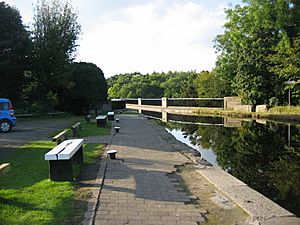Almond Aqueduct facts for kids
The Almond Aqueduct, also known as the Lin's Mill Aqueduct, is like a special bridge that carries the Union Canal over the River Almond in Scotland. You can find it west of Ratho, near Edinburgh. It's a really important part of the canal system, allowing boats to travel smoothly over the river below.
Quick facts for kids Almond Aqueduct |
|
|---|---|
 |
|
| Coordinates | 55°55′16″N 3°26′01″W / 55.9212°N 3.4337°W |
| OS grid reference | |
| Carries | Union Canal |
| Crosses | River Almond |
| Locale | West Lothian/City of Edinburgh |
| Maintained by | British Waterways |
| Characteristics | |
| Total length | 420 feet (130 m) |
| Height | 76 feet (23 m) |
Contents
History of the Almond Aqueduct
The Almond Aqueduct was designed by an engineer named Hugh Baird. He also got advice from another famous engineer, Thomas Telford.
Building the Aqueduct
This aqueduct was built at the same time as two other similar ones: the Slateford Aqueduct and the Avon Aqueduct. They all share a similar design.
Hugh Baird first thought about making the aqueduct with just one big arch. But he later decided to use the same design as the other two aqueducts.
Thomas Telford wasn't sure if stone arches were really needed along with the iron part. But Baird used both on all three big aqueducts.
The construction work happened between 1819 and 1821. It was done by a company called Messrs. Craven, Whitaker and Nowell. They were chosen because they had successfully built a stone bridge over the River Ouse.
Protecting the Aqueduct
In 1970, the Almond Aqueduct was given a special status. It was called a "scheduled monument." This means it's an important historical site that needs to be protected.
In 1971, it was also given "Category A status." This is the highest level of protection for historic buildings in Scotland. It was listed separately for both West Lothian and Edinburgh. This is because the River Almond forms the border between these two areas.
Later, in 2003, the entire Union Canal became a scheduled monument. This meant the aqueduct was actually protected twice! So, in 2019, its original scheduled monument status was removed. It's still protected as part of the canal and by its Category A listing.
How the Aqueduct is Designed
Early aqueducts, like the Barton Aqueduct from 1761, used a lot of stone. They also used a special clay called "puddling" to make sure they didn't leak.
Later, engineers started using cast iron. This happened after the success of The Iron Bridge in 1789. Famous engineer Thomas Telford used iron for aqueducts like Chirk and Pontcysyllte.
Using Iron for Strength
The Almond Aqueduct uses a strong iron trough. This iron trough helps to keep the water from leaking out. It also holds the water's outward pressure. This design made it possible to build the aqueduct more slender. It didn't need as much stone as older aqueducts, like the Kelvin Aqueduct.
The aqueduct is about 420 feet (130 m) long. It carries the Union Canal 76 feet (23 m) high above the River Almond. It connects Edinburgh to West Lothian.
Water Control and Access
There's a special gate, called a sluice, that lets water from the canal flow into the River Almond. This helps control the water level in the canal.
Close to the aqueduct, there's also a feeder. This feeder brings water to the canal from Cobbinshaw Reservoir.
You can reach the Almond Aqueduct by car using a track. If you like walking or cycling, you can also get there by following the Union Canal towpath.

